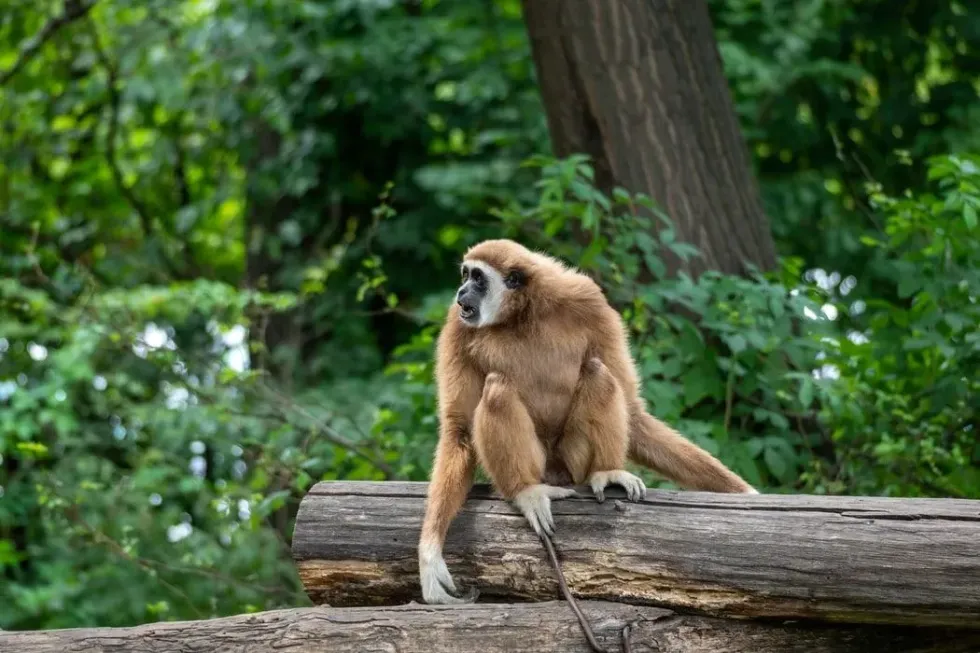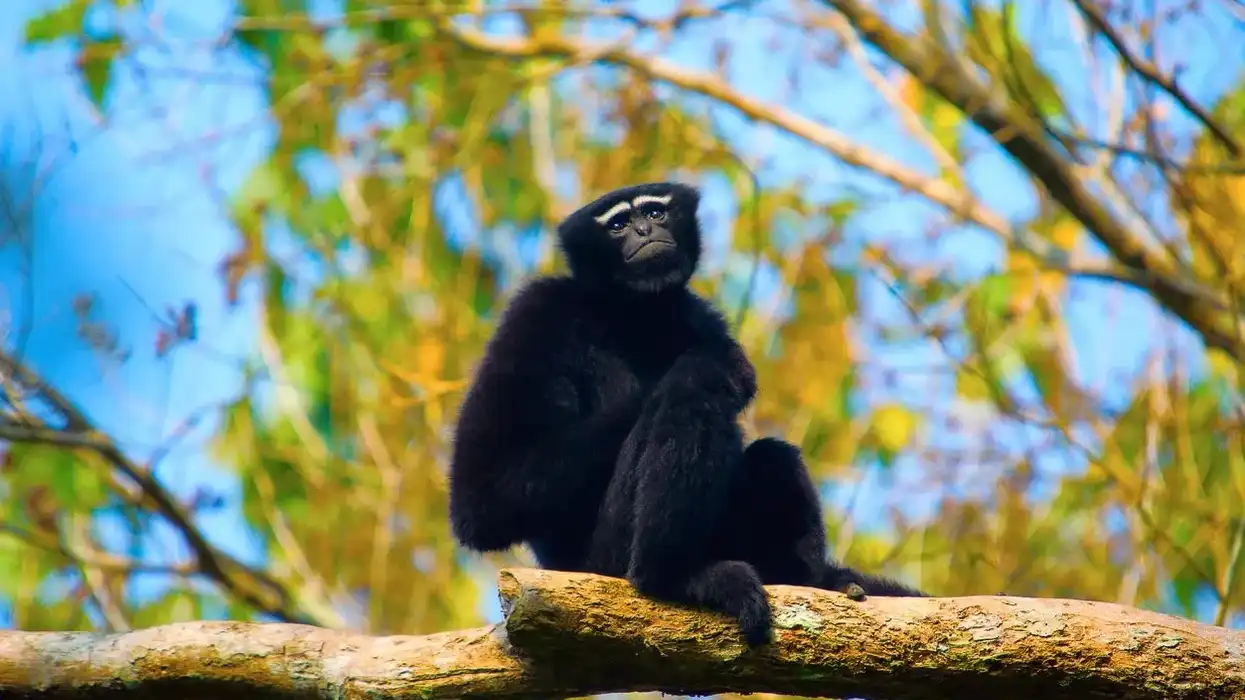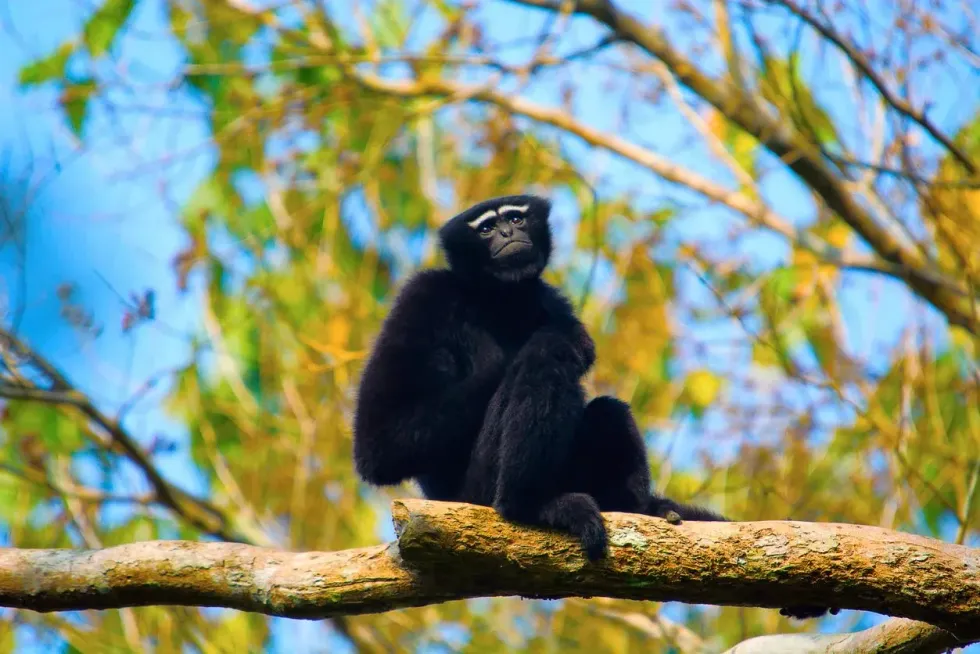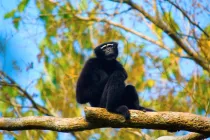Fun Hoolock Gibbon Facts For Kids

The hoolock gibbons are medium-sized primates found in parts of India, Bangladesh, and Myanmar majorly. These animals are known to live in tropical evergreen forests and are found generally living beside the rivers.
They are omnivorous and eat fruits, insects, and leaves for survival. These diurnal animals have distinct white eyebrows and are generally in black or gray-brown color. They are very territorial, mark their territory, and communicate by singing and other vocal calls.
The hoolock species are amazing runners and can run as fast as 34 mph (54.7 kph). Generally, the females are known to give birth to one offspring after a gestation period of about 230 days. The offspring takes about three years to become independent and six years to attain sexual maturity. Read on to discover more about these gibbons.
If you like reading these facts about hoolock gibbon, you could also check out some facts on the New World monkey and baboon.
Hoolock Gibbon Interesting Facts
What type of animal is a hoolock gibbon?
The hoolock gibbon is a primate of the genus Hoolock. The western hoolock's scientific name is H. hoolock. These animals are typically found in the tropical evergreen forests and shrub forests in India and neighboring countries.
What class of animal does a hoolock gibbon belong to?
The western hoolock gibbon, belonging to the species H. hoolock, and the other two subspecies belong to the class Mammalia. These animals are typically found in tropical regions like India and Bangladesh and are a part of the Hylobatidae family.
How many hoolock gibbons are there in the world?
The total population of the western hoolock gibbon and other hoolocks is unknown. They have a conservation status of Endangered species, so it is estimated that the number of western hoolock gibbon is very low (according to the IUCN Red List). However, what we do know is that there are 392 western hoolocks in Assam, India.
Where does a hoolock gibbon live?
Western hoolock gibbons and eastern hoolock gibbons both prefer to live in tropical evergreen forests and near water resources as these animals are known to eat fruits and insects. The gibbons live on trees and in groves in locations like Bangladesh, Myanmar, and the northeastern Indian states.
What is a hoolock gibbon's habitat?
This animal of the genus Hylobates, hoolock, is known to be found in tropical evergreen and scrub forests as these forests help them in providing them with their diet foods.
The hoolocks are generally seen living near water bodies, and they are mostly known to live beside the river Brahmaputra and Salween rivers in forests. They are found in the complete northeastern range of Indian states like Assam and Mizoram.
These animals cannot withstand extreme conditions, so they are seen living in the above locations throughout the year and for their entire lives.
Who does the hoolock gibbon live with?
H. hoolock or the Hoolock leuconedys gibbons live in small family groups, which consist of an adult male, an adult female, and their offspring. The Thomas Geissmann Gibbon Research Lab helps us to know more about the behaviors of these animals.
How long does a hoolock gibbon live?
The Hylobates hoolock or Hoolock leuconedys gibbons are known to live for about 25 years old in the wild. The lifespan of these animals depends on the availability of food and habitat.
They are known to do well in captivity too. They live for nearly 25 years in captivity. The oldest gibbon was a Müller's gibbon that lived until the age of 60.
How do they reproduce?
The Hylobates hoolock species are known to reproduce sexually where the males and females mate. They are monogamous. After mating, the female is known to give birth to young ones after a gestation period of about 230 days. The young ones become independent in about three years.
What is their conservation status?
The gibbon (hoolock) is smaller primate species that has the conservation status of Endangered according to the IUCN Red List. Their range of distribution in the eastern and western parts has been declining over the years due to various reasons like slash and burn farming, habitat loss, hunting for food and medicine, according to the IUCN Red List.
Their conservation is therefore essential owing to their conservation status.
Hoolock Gibbon Fun Facts
What does a hoolock gibbon look like?
The hoolocks that are found in various countries like Myanmar, Bangladesh, and the Indian subcontinent are medium-sized primates. There is not much difference between the males and females of this species, but the males are black, and the females are gray-brown in color.
They have distinct white eyebrows, long hands, and short legs. They have sharp teeth, and their claws can cause serious damage to their prey, predator, or humans too.

How cute are they?
Western hoolock gibbons are not that cute as they are medium-sized and have strong arms that are longer than their legs. They are known to sing alongside their territory, which is an attractive thing about these primates found in the tropical range.
The males and females are not very different in size but differ in body fur or hair color. The baby gibbons can be considered somewhat cute too.
How do they communicate?
Communication among western hoolock gibbons happens with the help of vocal calls and songs that the males and females are seen singing to mark their territory, and their offspring joins them. Communication – vocal calls or songs – is the only mode by which they are alerted about predators.
Loud calls alert everyone around. The songs help the group and family to stay together in their territory.
How big is a hoolock gibbon?
Western hoolock gibbons are about 24-35 in (60-90 cm) in length and weigh around 13-20 lb (6-9 kg). These species of gibbons (hoolocks) are medium-sized gibbons and primates and are generally hunted by the bigger wild animals like the cheetah, which is almost two to three times the size of these hoolocks.
How fast can a hoolock gibbon run?
Hoolock gibbons are very energetic animals and are known to run at a speed of about 34 mph (54.7 kph). They are generally seen running at high speeds either to save themselves or to hunt their prey in their home range.
These species are generally seen as living in small groups in the forest range on the trees and feed mostly on leaves, fruits, and insects.
How much does a hoolock gibbon weigh?
Hoolock gibbons are known to live in small groups and stay near the river in groves as it becomes easy for them to search for food. Hoolocks weigh around 13-20 lb (6-9 kg). These animals are small-sized primate species that are known to live in groups in the forest.
What are the male and female names of the species?
The hoolock gibbons do not have any names in particular for the adult male and female species. These gibbon species (hoolock) are known as Hoolock hoolock in terms of scientific naming.
The western hoolock primates are also called (Hylobates hoolock) or the leuconedys in many areas. They are also referred to as eastern or western hoolock gibbons based on the location of their natural habitat or forest.
What would you call a baby hoolock gibbon?
Hoolock gibbons do not have any particular names for the baby gibbons and are generally referred to as offspring once they are given birth by the females. The baby gibbons can be called young primates or young hoolocks too. They mature at six to eight years.
What do they eat?
This primate species is known to be an omnivore animal as it depends on insects, leaves, and fruits. They are generally seen eating insects, eggs of other animals, fruits, and leaves from various trees in their natural habitat.
The gibbons are quite vulnerable in their habitat as they are hunted by a lot of wild animals and some of the predators of these primates are leopards, birds of prey, and snakes.
Are they active?
Hoolock gibbons are a very active species of primates as these animals are known to wake up early in the mornings and usually defecate and urinate in the morning. They are seen climbing and running in their natural habitat and stay in their groves during the nighttime.
Would they make a good pet?
The hoolock gibbons are known to live in groups and are very social and territorial animals. These gibbon species do not make good pets.
These are also known as lesser apes and are quite aggressive, and do not get along well with humans.
Another name for the hoolock is leuconedys, and they are generally found living near rivers in tropical regions as they depend on food like insects and fruits, and their diet consists of many fruits, insects, and leaves from the trees in their natural habitat, forest.
Gibbons (hoolock) are even traded in some countries, and the adult males are black, and females are brown in color, and these adults are killed in order to trade their babies.
Did you know...
The white-browed gibbon is the western hoolock gibbon.
Hoolock gibbons or the Hoolock leuconedys have strong and long arms just like other apes and primates, which are much longer than their legs. These arms help them in climbing trees and even fighting in order to prevent themselves from attacks.
Gibbons are not monkeys. They are apes. The hoolock gibbon is the only ape found in the Indian subcontinent.
Where is the hoolock gibbon found in India?
There are gibbons in India. The hoolock gibbon (Hylobatidae) species are found in many places but are mostly found in the northeastern states of India, like Assam, and in tropical and sub-tropical evergreen forests near the Brahmaputra river.
The hoolock gibbon species are the most famous in India as they are found in the majority.
According to Choudhury in 1987, these species of gibbons are also found near the Lohit and Dibang rivers that are in Arunachal Pradesh. Apart from that, these primates are seen in all of the seven sisters or the northeastern states of India.
The adult gibbons are known to live in groups and prefer to stay in groves.
As the Brahmaputra river passes through Bangladesh and Myanmar too, this species of gibbons are seen in these countries as well. The species hoolock are known to hunt on small insects, and their diet includes fruits, leaves, and insects which they look for in small groups.
How many species of gibbon are there?
Hoolock gibbons are one of the 16-17 estimated gibbon species that are there in the world, present in various countries like India, Bangladesh, and Myanmar.
The gibbons are quite famous in India and that too in northeast India and are also known as eastern hoolocks as they are found hunting for food in northeastern India. These species of gibbons are divided into four groups (genera) which are called Hoolock, Hylobates, Nomascus, and Symphalangus.
The white-cheeked gibbon belongs to the genus Nomascus and the siamang gibbon belongs to the genus Symphalangus.
Here at Kidadl, we have carefully created lots of interesting family-friendly animal facts for everyone to discover! Learn more about some other mammals from our Diana monkey facts and Old World monkey facts pages.
You can even occupy yourself at home by coloring in one of our free printable hoolock gibbon coloring pages.
We Want Your Photos!
More for You
See All
Bachelor of Commerce specializing in Accounting and Finance, Master of Business Administration

Divya RaghavBachelor of Commerce specializing in Accounting and Finance, Master of Business Administration
With a diverse range of experience in finance, administration, and operations, Divya is a diligent worker known for her attention to detail. Born and raised in Bangalore, she completed her Bachelor's in Commerce from Christ University and is now pursuing an MBA at Narsee Monjee Institute of Management Studies, Bangalore. Along with her professional pursuits, Divya has a passion for baking, dancing, and writing content. She is also an avid animal lover who dedicates her time to volunteering for animal welfare causes.
Bachelor of Commerce specializing in Marketing and HR

Pradhanya RaoBachelor of Commerce specializing in Marketing and HR
With a Bachelor’s degree in Commerce from Christ University, Bangalore, Pradhanya's passion for the English language and literature led her to explore the field of content writing, where she has gained extensive experience in writing, reviewing, editing, and fact-checking. She has also earned certifications in Google Ads Search, Google Ads Display, and Social Media Marketing, showcasing her proficiency in digital marketing.
Disclaimer
1) Kidadl is independent and to make our service free to you the reader we are supported by advertising. We hope you love our recommendations for products and services! What we suggest is selected independently by the Kidadl team. If you purchase using the Buy Now button we may earn a small commission. This does not influence our choices. Prices are correct and items are available at the time the article was published but we cannot guarantee that on the time of reading. Please note that Kidadl is a participant in the Amazon Services LLC Associates Program, an affiliate advertising program designed to provide a means for sites to earn advertising fees by advertising and linking to Amazon. We also link to other websites, but are not responsible for their content.
2) At Kidadl, we strive to recommend the very best activities and events. We will always aim to give you accurate information at the date of publication - however, information does change, so it’s important you do your own research, double-check and make the decision that is right for your family. We recognise that not all activities and ideas are appropriate for all children and families or in all circumstances. Our recommended activities are based on age but these are a guide. We recommend that these ideas are used as inspiration, that ideas are undertaken with appropriate adult supervision, and that each adult uses their own discretion and knowledge of their children to consider the safety and suitability. Kidadl cannot accept liability for the execution of these ideas, and parental supervision is advised at all times, as safety is paramount. Anyone using the information provided by Kidadl does so at their own risk and we can not accept liability if things go wrong.
3) Because we are an educational resource, we have quotes and facts about a range of historical and modern figures. We do not endorse the actions of or rhetoric of all the people included in these collections, but we think they are important for growing minds to learn about under the guidance of parents or guardians.







